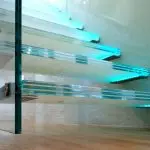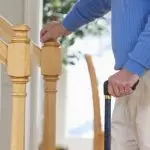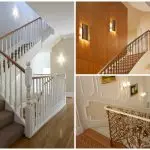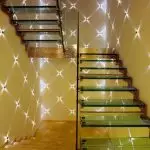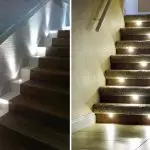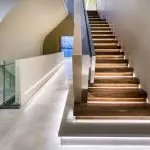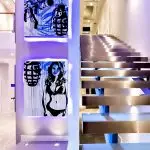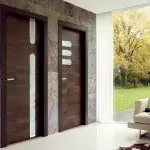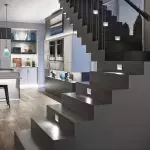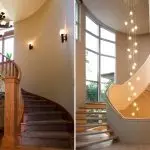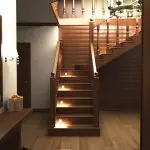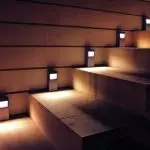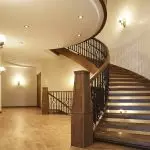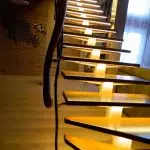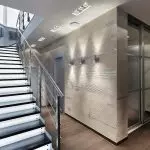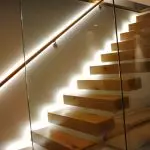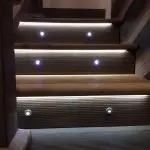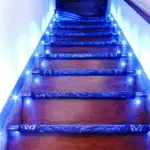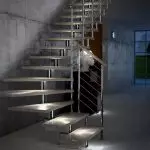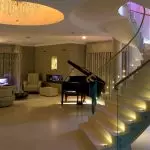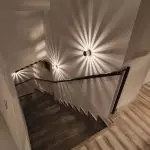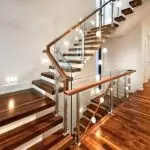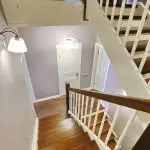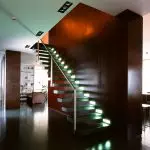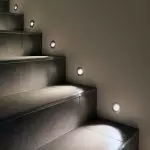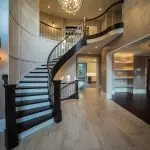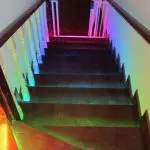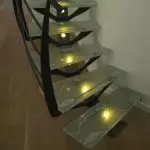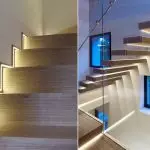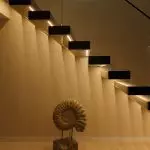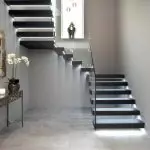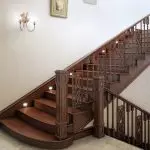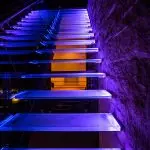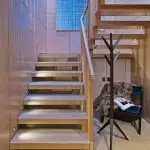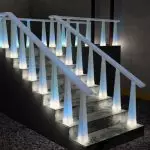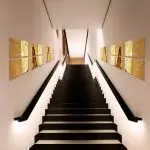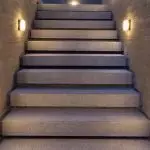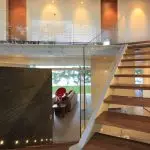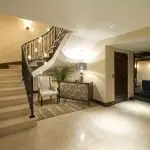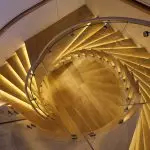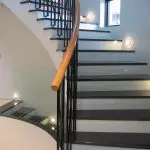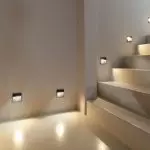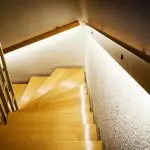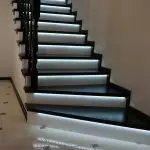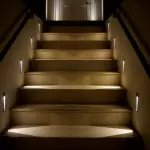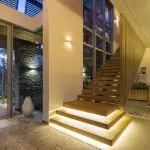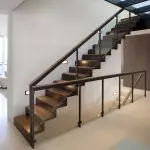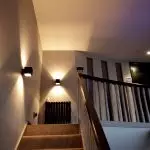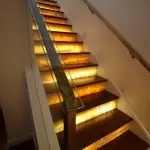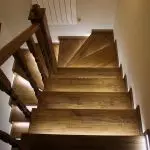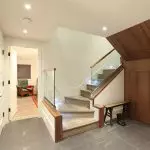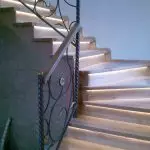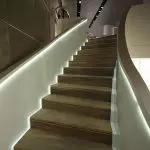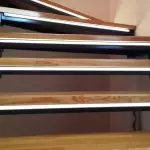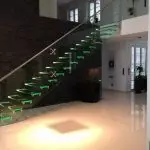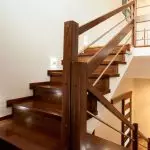The backlight of the stairs in the house is a very important factor responsible for the safety and convenience of using the design. With the help of lighting, you can unusually decorate the interior using various visual effects. Today there are many options for arranging the backlight for stairs, each of which should be carefully learned to choose the most suitable.
The main criteria for selecting the backlight for the stairs
Natural light sources for the lighting of the stairs in the house does not always turn out to be enough to ensure the safety of movement along the steps. Therefore, it is advantageously installed on the staircase to mainly set the backlight in the form of LED, neon lamps or other lighting devices. Installation is performed by width and length of steps, along the edges and corners or on the ceiling directly above the staircase. Also often these options are combined with each other.
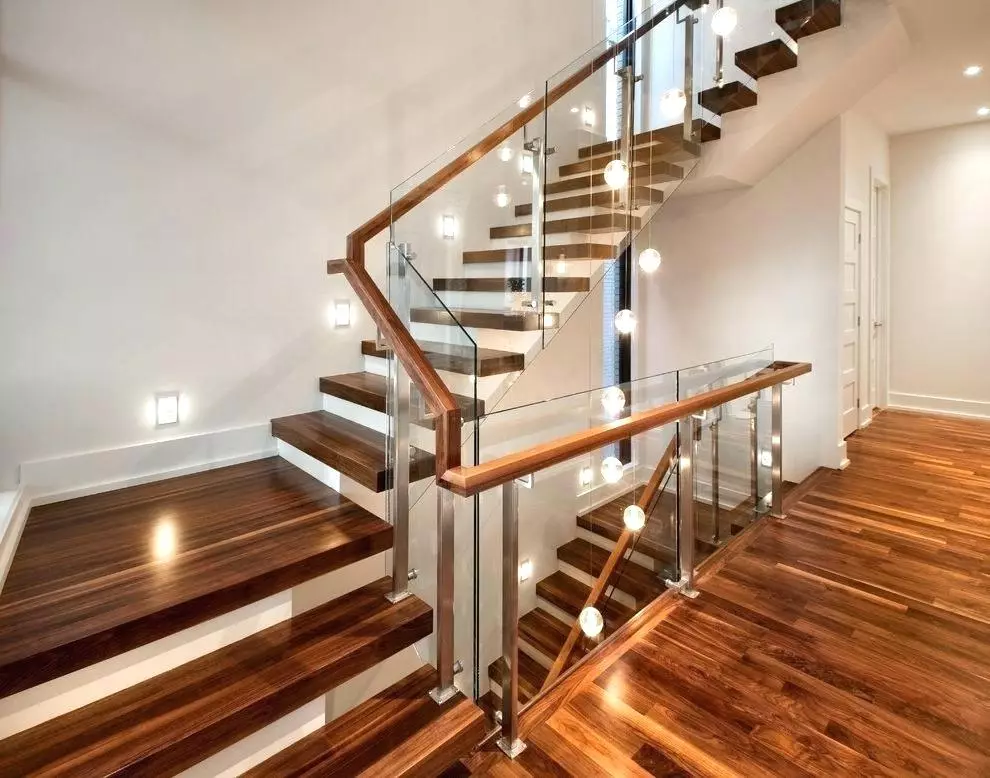
When choosing a type of lighting, it is worth repelled from the following recommendations:
- The devices should not distort the shape and dimensions of the steps in the dark, and also do not throw the shadow. Otherwise, a walking person can be stupid and fall.
- The first thing to be considered is that the lighting area depends on the length of the descent. Thus, the longer the length of the stairs on the second floor is going, the more lighting should fall on it.
- For long stairs, a diffused lighting type is required. Best of all this can be achieved with the help of point lamps.
- If the staircase is made of wood, wood should be impregnated with special substances that provide resistance to high temperatures.
It is also worth considering the overall design. Wooden design will be best combined with yellow light, and metallic - with white lighting.
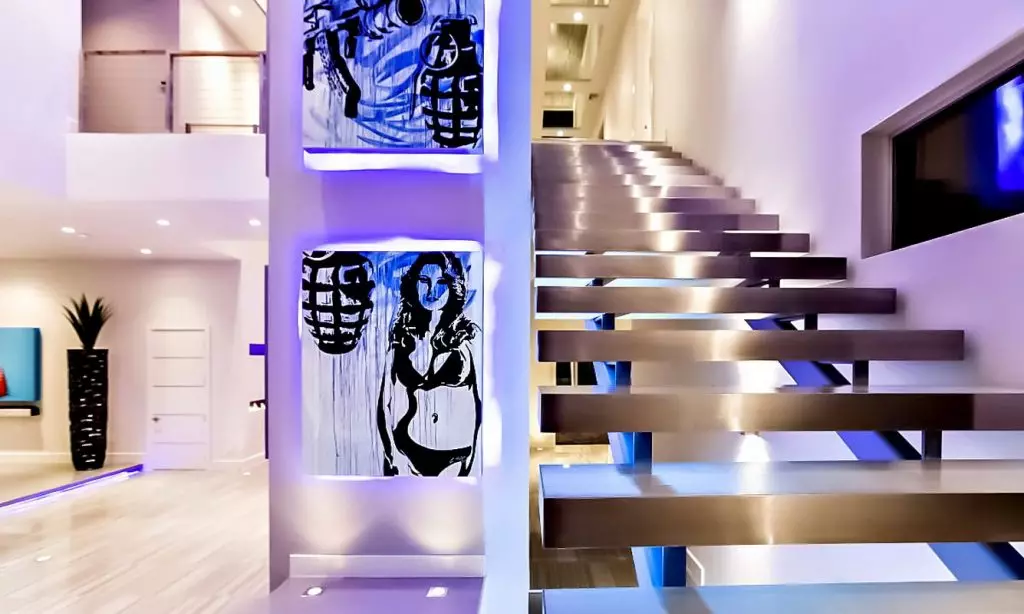
The glass looks harmoniously with many shades, so the color of the lighting is selected based on the general design. Although such criteria are not mandatory and the owners can experiment in this matter.
Ways to illuminate stairs
In many private houses, the design on the second floor serves as a decorative component of the whole house. The backlight should correctly illuminate the structure, highlighting its aesthetic side. The inclusion of all the light on the stairs or in its separate areas is performed manually or automatically. In the second case, the automatic control function may be part of the Smart Home system or installed additionally.Automatic backlight
Automatic control allows to facilitate and simplify the operation of lighting devices. A smart automation system can be equipped with various control devices. It can be:
- Motion sensors. The light automatically lights up as soon as someone enters the room. After a person rose or descended, after a certain period of time, the light goes out, as a rule, after 20-30 seconds.
- Timer time. Allows you to include lighting daily at the same time. It is also convenient, especially for very busy people.
- Load sensor or touch. The light turns on with external exposure to the steps or when touched the hand to the railing.
- Sound sensor. Instantly includes light in cotton or voice signal.
Article on the topic: How to calculate the stairs to the second floor: optimal parameters
The correct and thought-out setting of automatic backlight will allow rational and economically to use electricity.
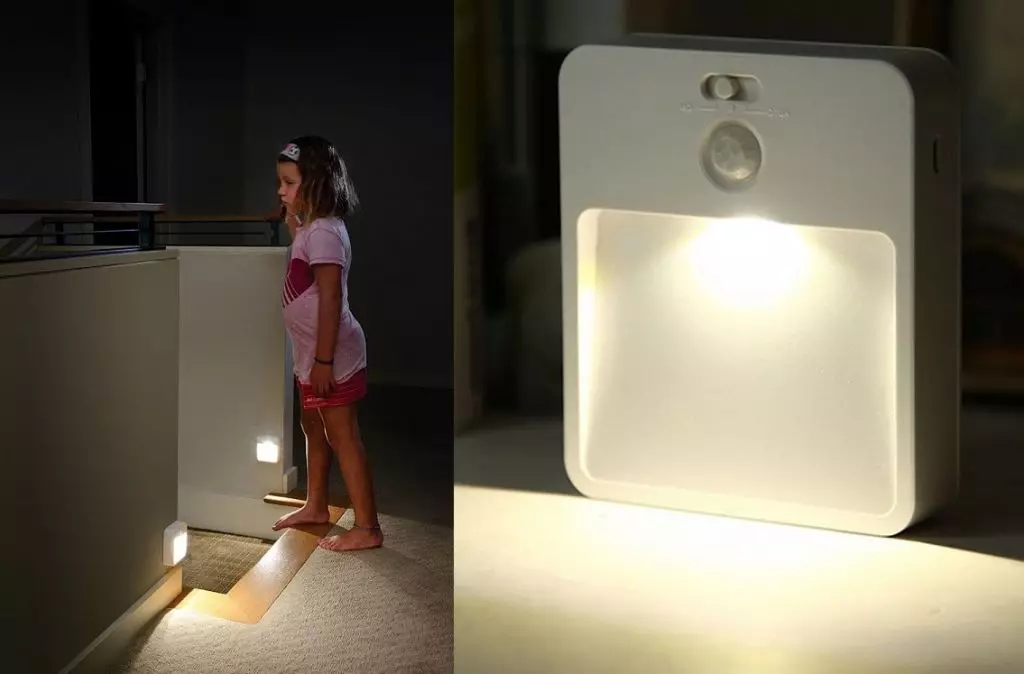
Wireless and Normal Network Backlight
To date, not only network sources, but also wireless, which are used on the designs and other parts of the house, has become possible to illuminate the stairs.Wireless
Provided from autonomous power and is the most profitable convenience and safety. As a rule, such a smart system consists of several motion sensors and lighting elements - 4 pcs. And more, depending on the length of the staircase.
Composite devices are configured under a certain frequency and do not require additional regulation. Modules operate from ordinary batteries.
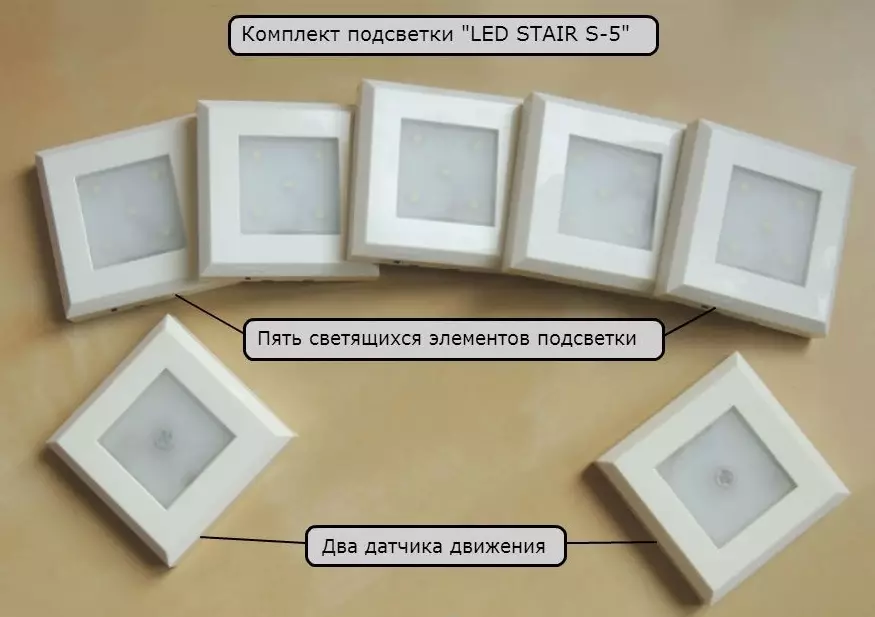
Wireless type lighting system has many advantages, in particular:
- deprivation of the need to include main lighting;
- autonomy that allows not to use electricity;
- the ability to use when the power is disconnected in a private house;
- Built-in illumination sensors include highlighting only in the dark;
- Easy to install all parts that do not require special knowledge and skills;
- Installation is carried out without the need to drill the walls and the ceiling.
When the lighting system is installed, it is also worth considering a high degree of security. Wireless devices are not worried overheating, which reduces to zero the possibility of fire.
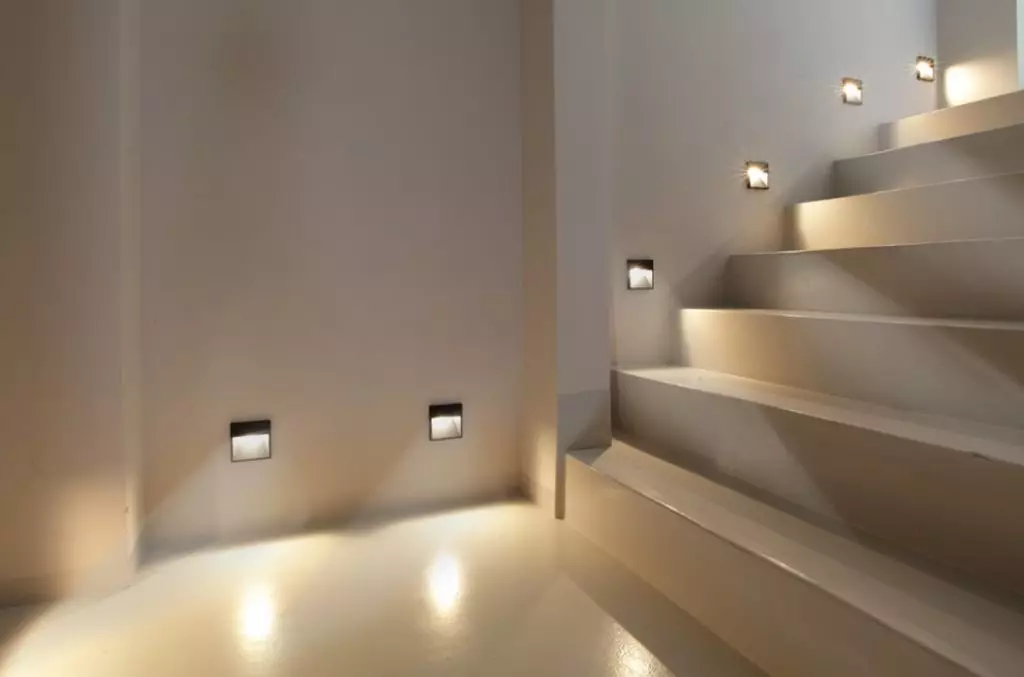
Backlight from the network
Cable wiring is a bit more complicated, so the process performs a certain experience and skills. As a rule, the installation of the components of the system is carried out by a specialist. A large scale of work requires appropriate costs. In addition to directly lighting devices, you need to purchase many different wires, motion sensors, with automated switch-on mode - relays, power supplies and other items.Types of lighting and place of their installation
The backlight of the stairs and designs on the second floor as a whole should be functional and organically combine with the design forms of the stairs. Therefore, the lighting option is better to choose even during the planning stage of the private house.
LED ribbons and tubes
LED ribbons consist of an aluminum sheet on which the lamps are placed. The devices are different colors, which will allow you to choose the most optimal solution for the type of stairs or interior.
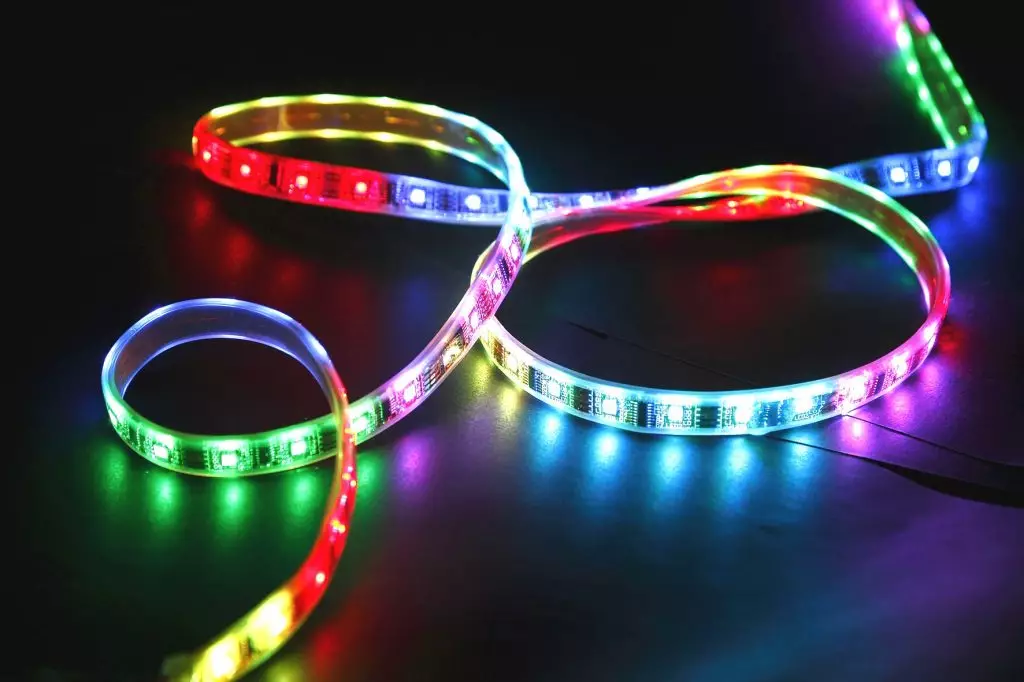
LED backlight makes it possible to highlight the face of each step separately. The scattering light creates a comfortable home furnishings, filling the room with warmth and comfort.
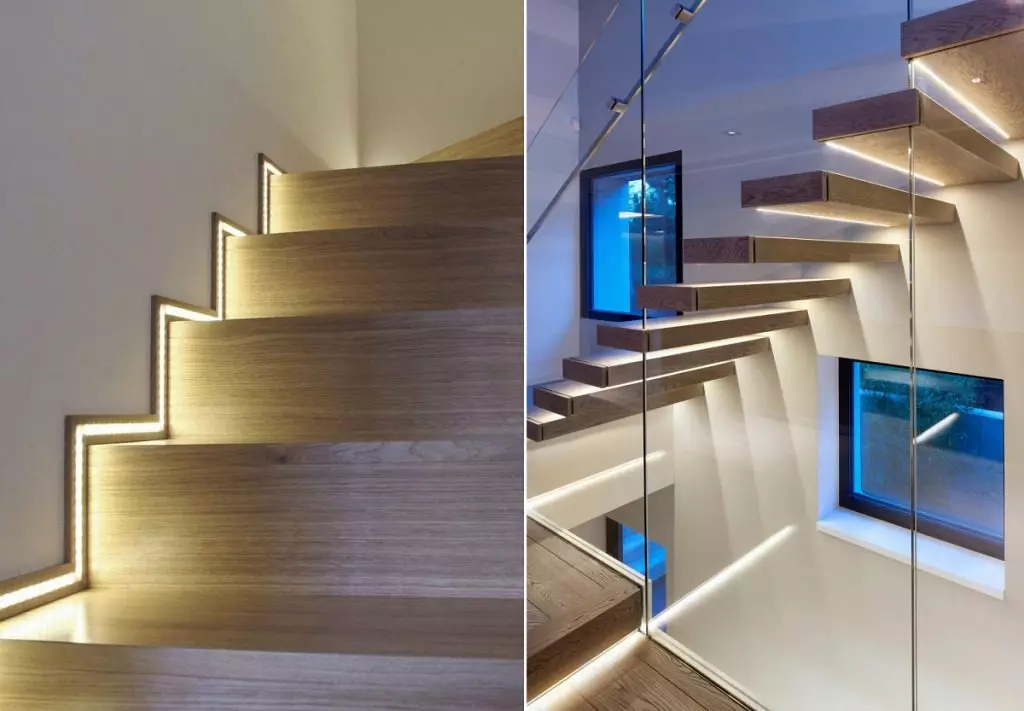
Neon elements consist of an elastic tube in which the cable is installed. The light can be directed by 360 degrees.
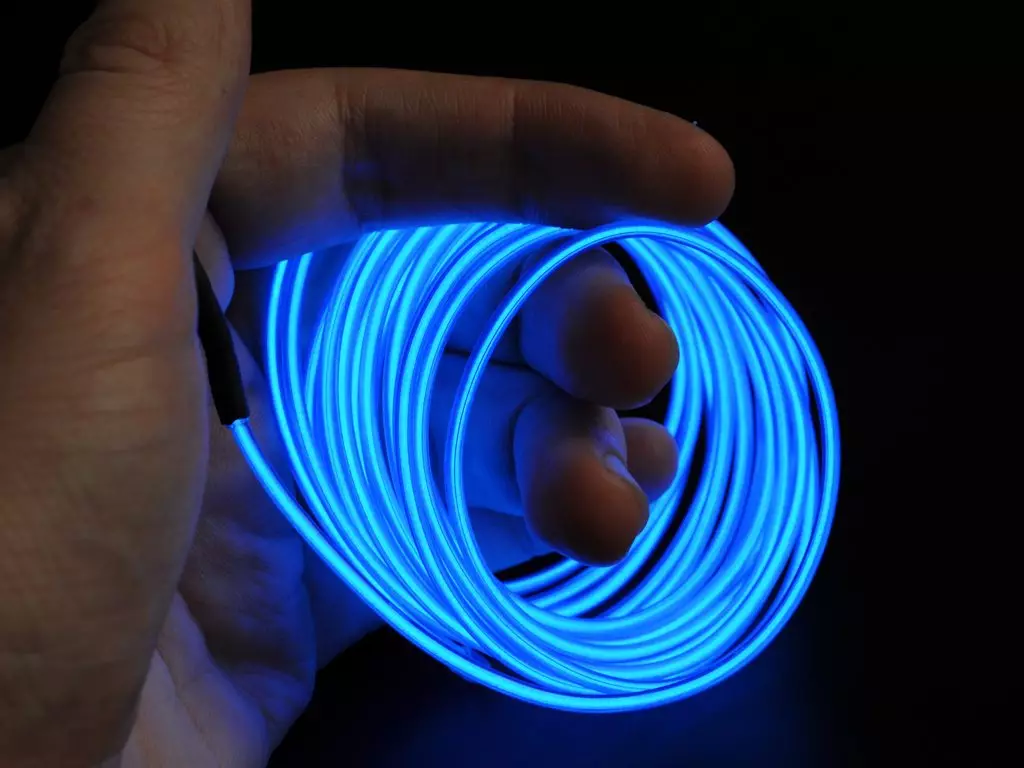
Point lighting stairs
Point type lamps provide proportional and uniform distribution of light in the room. The service life is quite long, but the instruments are heated when working. Therefore, the lamps should not be closely in contact with other objects. In addition, through the differences in the bulb network in the devices, they burn out, which leads to additional financial spending. Large ass definitely refer to the category of those phenomena that you like absolutely everyone. If you are a lovedant porn and cool ass, then do not hesitate and go on the link.
Article on the topic: How to make a staircase with your own hands: choosing a type of construction, calculation of parameters and installation
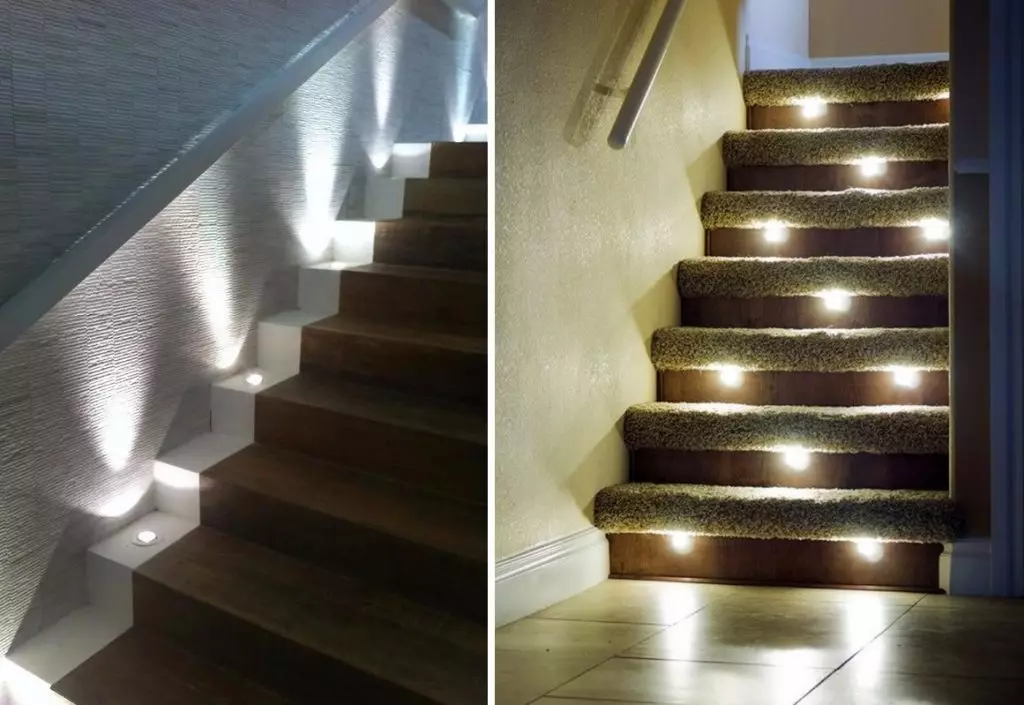
Wall bras
Lighting with wall braids is considered the most common. There are several types of models:
- Sour surfaces are fixed with the back side on the wall;
- sconium with a bracket, which allows lamps at different distance from the wall;
- The lamp, built into the wall - requires a mounting deepening minimum 4 cm.
Predominantly shed are installed in false walls, plasterboard partitions.
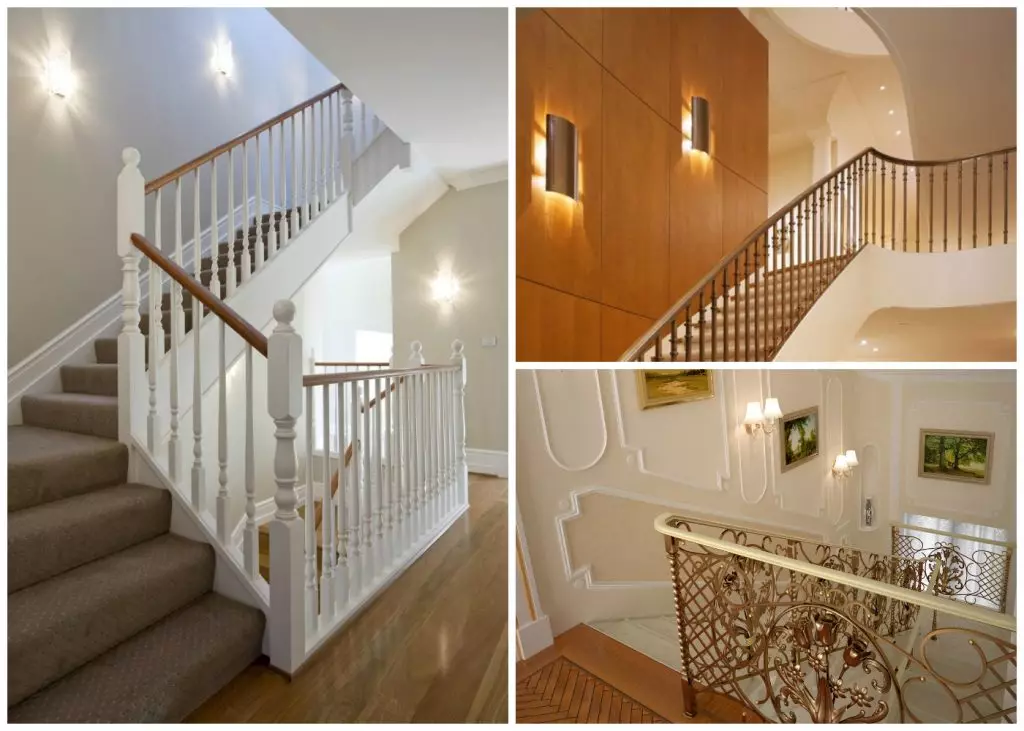
Lighting Ladder Lesry
A non-standard option is considered to use a wall chandelier for staircase marches. Preferably, such design is observed in hotels or large estates. Large lamps are pretty dimensional in length.
The chandelier is relevant with high ceilings and the corresponding interior design.
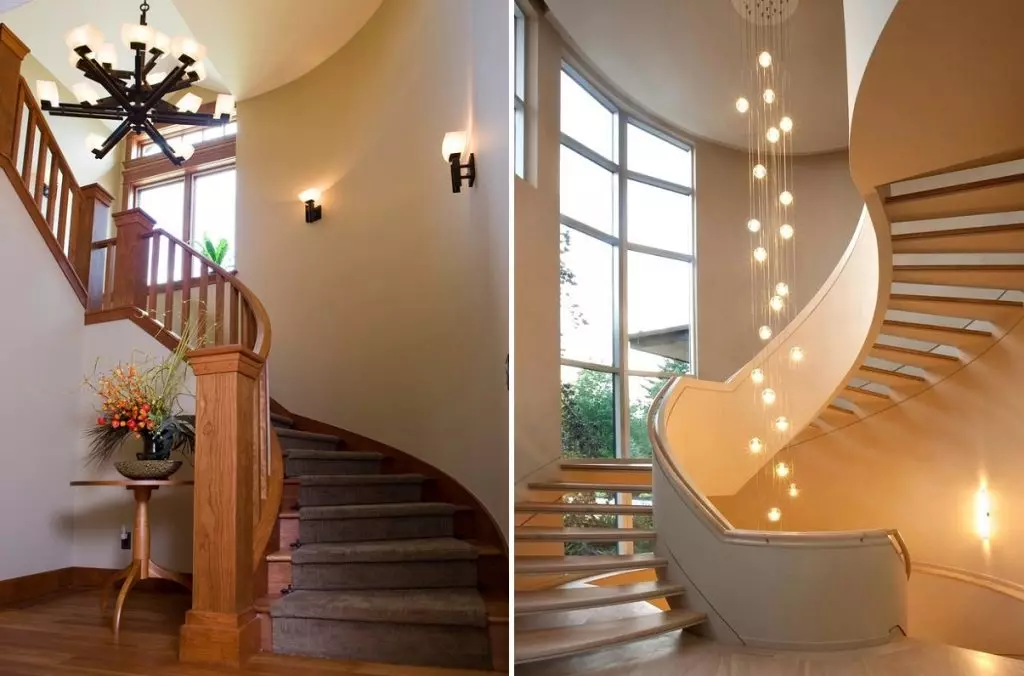
Combined lighting option
Based on the ladder parameters, the lighting can be made and combined. It is impressive and fashionable in the modern interior looks like a combination of wall, ceiling and built-in lighting.
It is important to pay attention to the fact that thoughtfully arranged built-in or wall light elements are capable of visually changing the geometry of space. For example, when the lamps are directed up, you can visually increase the height of the ceiling.
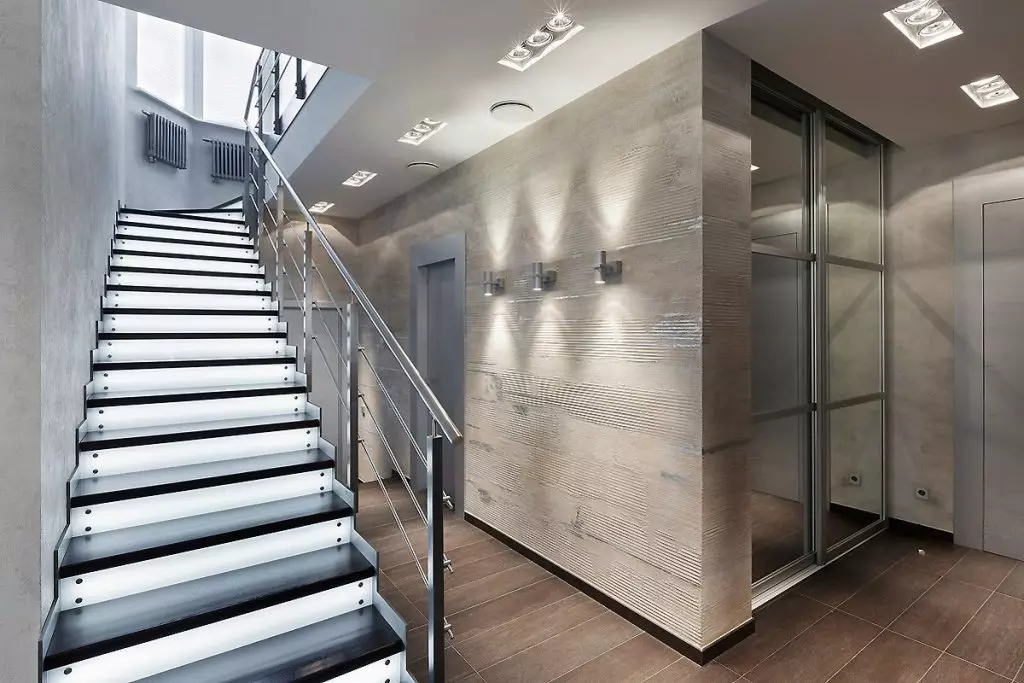
Illumination of the stairs do it yourself (instruction)
Pretty original and beautifully looks backlighting the ladder LEDs. Light effects serve as a key to comfortable movement, transform to unrecognizable interior. The equipment is sold in full, so in the presence of elementary knowledge, you can assemble the system with your own hands.Normal
For easy backlighting from the network, a switch will be required. Side surfaces or stages are equipped with a LED ribbon. The system starts with the button located on the wall. To work, you will need an aluminum profile, metal scissors, a ruler or roulette, self-tapping screw, drill and screwdriver.
To make the appearance of the backlight more attractive and hide the LED tape, also acquire a plastic plinth to hide the wiring.
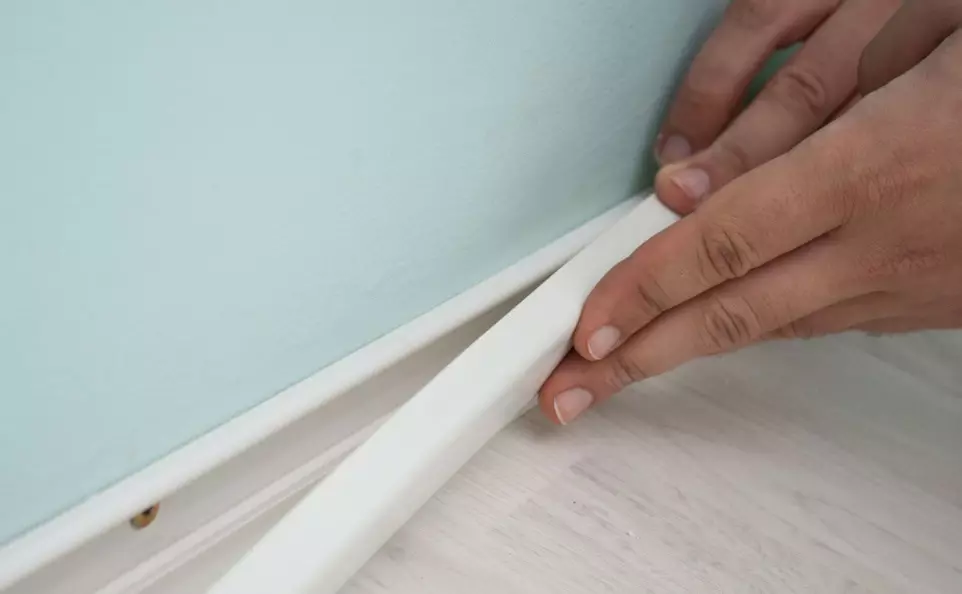
The process of the LED backlight device from the power grid is as follows:
- At each step of the stairs or on the junction between the wall and steps you need to install an aluminum profile that is fixed using self-samples.
- The installed profile must be deguted. For this purpose, alcohol, White spirit or other means is usually used.
- The LED tape must be cut into segments, the length of which corresponds to the width of the steps, can be made by 5-8 cm less.
- A protective film is removed from the tape, the finished elements are glued to the profile installed in advance.
- Next you need to display contacts for LEDs. This is done on both sides of the tapes, extreme contacts are connected to the total electrocabyl.
- It remains only to connect the controller and power supply, start the system. To hide the LED tape, a plastic plinth can be installed on the profile.
Article on the topic: Ladder in the attic: What it is better to choose and how to install yourself?
The figure below shows an exemplary diagram of connecting the LED backlight for a single-stage staircase.
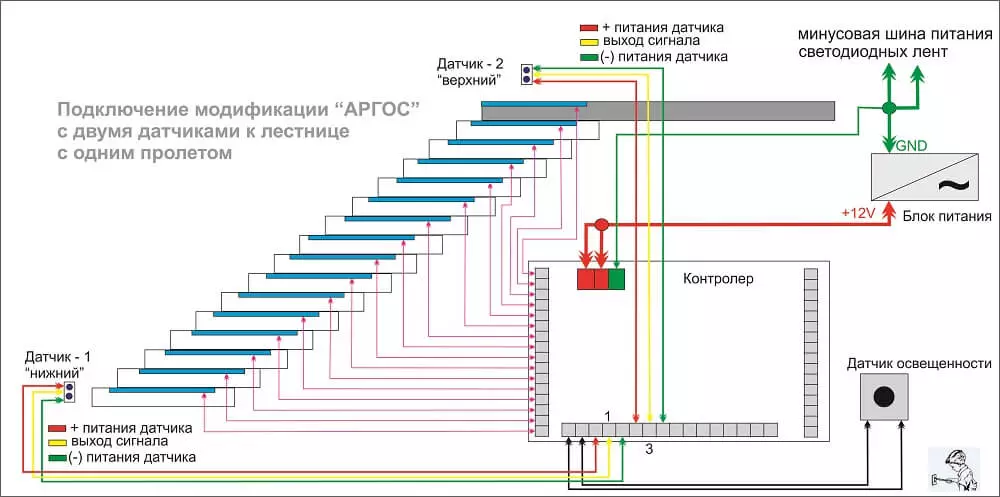
On video: how and what to connect the LED ribbon.
Automatic
The scheme is based on the relationship between the sensor and the controller (mainly use the Arduino / Arduino device). Sensors are installed directly opposite the bottom and upper steps, and when moving, the LED controller is activated.
To assemble an automatic system, you need to purchase the following components:
- The controller is the main component of the whole scheme, suitable for most stairs;
- Board with schemes required to install the controller;
- Driver LEDs - a microcircuit connecting with the outputs of the controller;
- Sensors sensors - they will react to movements;
- a photocell that is installed so that the light does not turn on during the day;
- Also required wires for connecting and connecting all components.
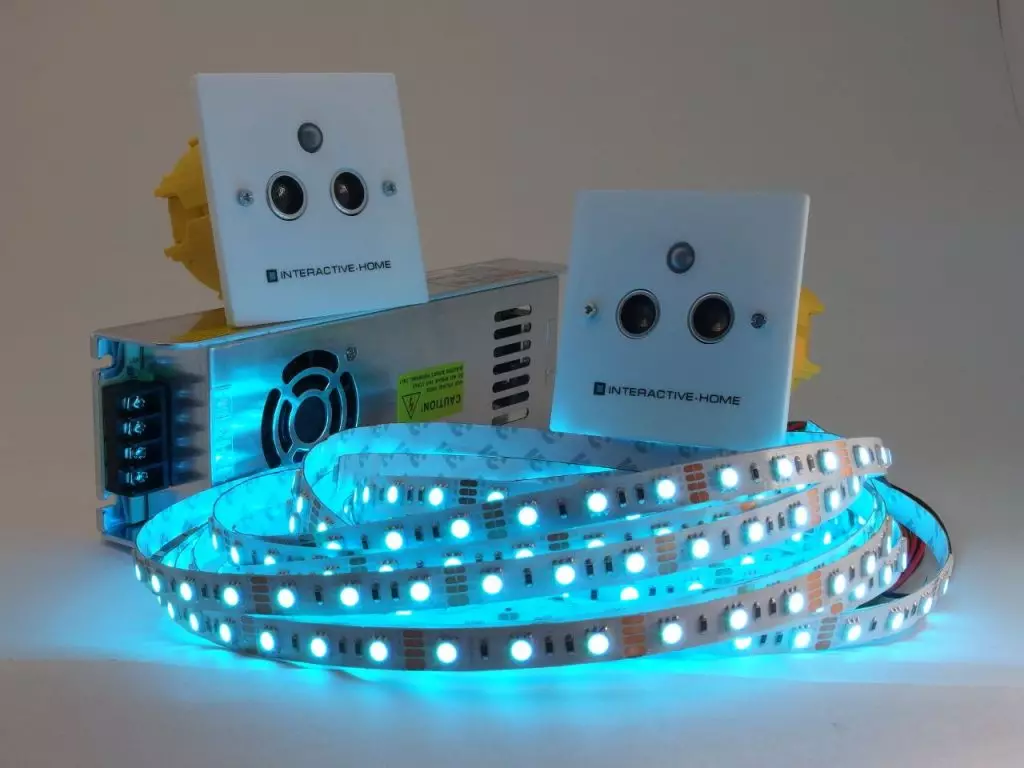
Before installing, you need to assemble the scheme and run in test mode to make sure that the components are in the work form. For this you need:
- Connect the controller to the computer and download the control code.
- Install the controller on the board, connect to the LED drivers and connect to the outputs on the tape.
- Make additional two outputs for sensors responsible for switching on light.
In addition to the above components, it is also recommended to install a switch that allows you to turn off the system or switch to permanent mode.
On video: Smart backlighting stairs - how it works.
After assembling the system begins the installation. Automatic LED backlight Arduino ladder is mounted in the following order:
- From the tapes are cut off the required number of fragments.
- Ribbons at the ends are closed with special connectors.
- After degreasing steps, LED ribbons are glued with acetone.
- Opposite the bottom and upper steps, holes are made in which the peales are installed and touch sensors are taken.
- The wires from the sensors are triggered along the strokes under the step, and the cable-channel cable is mounted on the Koser.
- The control module box is placed in a closed place, often under the stairs.
- The conductors are connected, after which the cable is connected to the connector on the board.
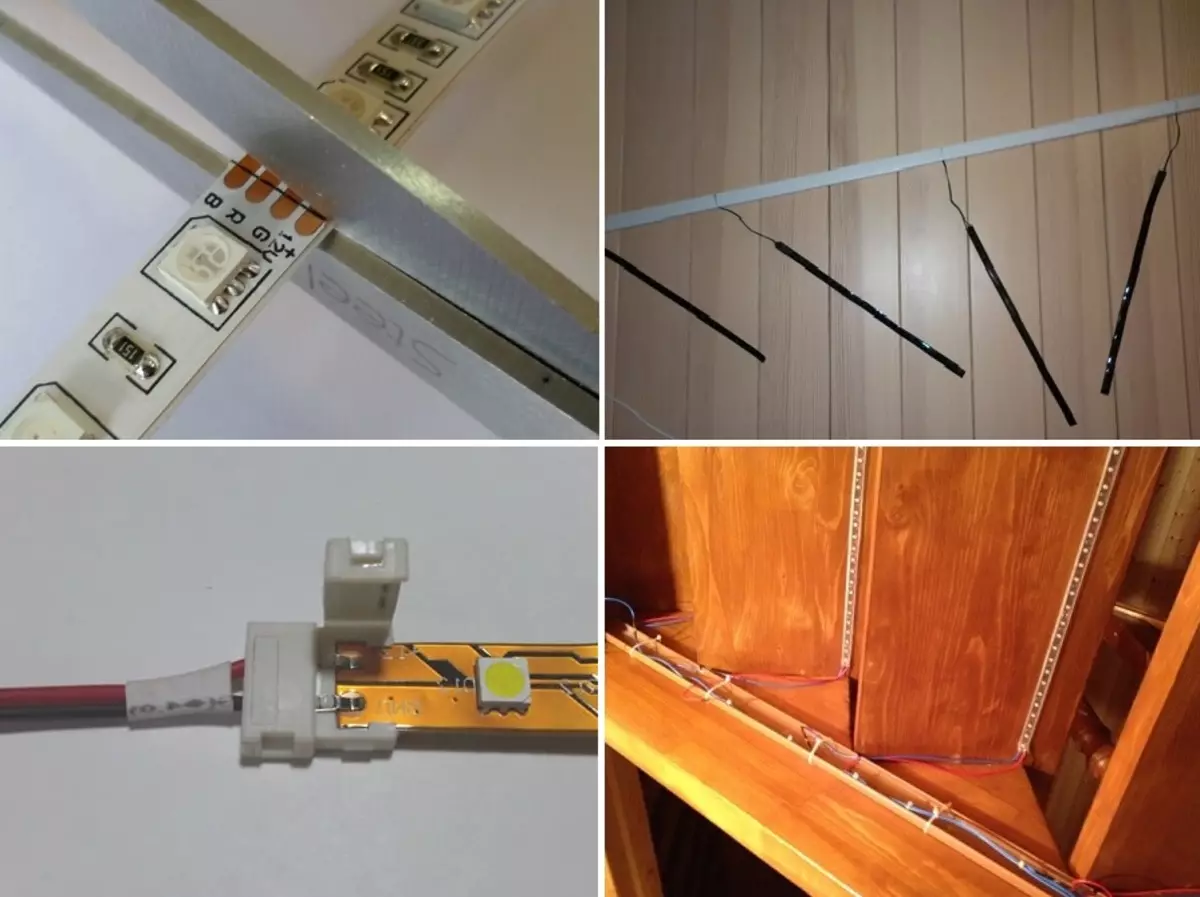
After the test check, if no problems and inaccuracies are detected, this system starts on the permanent operation mode.
On video: Mounting process and connecting the automatic backlight of the stairs.
After reviewing the ways to organize the stairs and realizing which types of lighting devices it is better to use in each individual case, you can safely make the development of your own scheme. Also need to make a list of the necessary materials and the equipment used.
Overview of automatic LED backlighting steps (2 video)
Functional and decorative illumination (58 photos)
